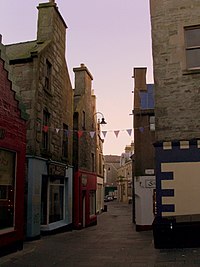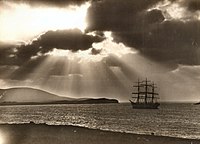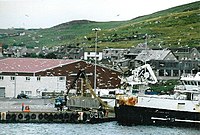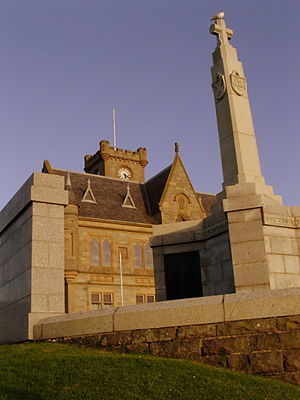Lerwick
| Lerwick | |
| Shetland | |
|---|---|
| File:Lerwick.shetland.2.jpgt Lerwick | |
| Location | |
| Island: | Mainland |
| Grid reference: | HU474414 |
| Location: | 60°9’18"N, 1°8’42"W |
| Data | |
| Population: | 7,070 |
| Post town: | Shetland |
| Postcode: | ZE1 |
| Dialling code: | 01595 |
| Local Government | |
| Council: | Shetland |
| Parliamentary constituency: |
Orkney and Shetland |
| Website: | http://www.shetland.org |
Lerwick is the chief town of Shetland and the most northerly town in the United Kingdom. It is the islands' commercial and social heart and its main port. It is the port of call for the Shetland lifeline ferry service. From the latter years of the twentieth century, Lerwick has thriven from of the North Sea oil industry.
Lerwick stands on a fine natural harbour on Bressay Sound on the eastern coast of Shetland's Mainland. The town is nearly equidistant from Torshavn in the Faeroe Islands to the west, Bergen in Norway to the east and Aberdeen to the south on the mainland of Great Britain. The town's name comes from Old Norse Leirvík, meaning 'muddy bay'.

History

Lerwick scarcely existed until the early 17th century. The ness on which it stands belonged to the proprietors of the large township of Soond to the south of it. They used it for grazing. A few huts sprang up there when Dutch fisherman began to come to Bressay Sound in the late 16th century. On two occasions the court at Scalloway moved to suppress the new settlement. The building of Fort Charlotte in its first incarnation gave a boost to Lerwick, and by the end of the century a good few merchants were based there.
Lerwick continued as a fishing village to the beginning of the 19th century, when the Napoleonic Wars resulted in another building spurt. Until then the settlement stretched mainly along its front road (today's Commercial Street) which runs from north to south, from Fort Charlotte via Market Cross onto The Lodberries a group of Lerwick's oldest buildings. In 1818 Lerwick became a Burgh of Barony and in 1833 a 'Police Burgh'. Both events and the resulting status as a kind of self governing local authority laid the foundation of the prosperous development of the modern town of Lerwick.

The following years showed a rapid development along Lerwick's back roads such as Hillhead and other roads running more or less parallel to Lerwick's main road which then developed into Lerwick's shopping street. The building of the new Town Hall since 1882 highlights Lerwick's new role as Shetland's modern capital.
Parallel to the town itself the harbour businesses developed from the piers and jetties of "old Lerwick" to the north: from North Ness to Hay's Dock and further on thus integrating the formerly independent places like Holmsgarth and Gremista into the modern town and its economy. The Lerwick Harbour Improvements Act 1877 and the constitution of the "Lerwick Harbour Trust" (now Lerwick Port Authority) were important marker stones for further economic growth within the harbour and the town of Lerwick.
Today Lerwick is home to one of Europe's largest sea-fishing factories, the Shetland Catch, and it frequently sees many cruise liners during the summer season.
